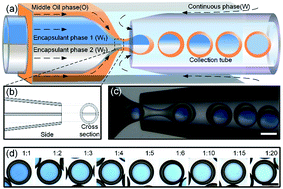A simple microfluidic method for one-step encapsulation of reagents with varying concentrations in double emulsion drops for nanoliter-scale reactions and analyses
Abstract
This work reports a simple microfluidic method for one-step encapsulation of two reagents with varying concentrations in water-in-oil-in-water (W/O/W) double-emulsion drops. This method not only enables nanoliter-scale reactions and analyses under a series of controlled concentrations of two reagents without stopping the experiments or changing solutions, but also protects the reactions from external disturbance for an extended amount of time by the core–shell structure. To achieve this, a capillary device embedded with a theta-shaped tube is fabricated to produce monodisperse emulsion drops, in which the concentrations of the reagents encapsulated are varied by tuning the flow rates in the two individual channels of the theta tube. The relative volume ratio of the encapsulated reagents can reach up to 1 : 20. In addition, microcapsules converted from emulsion drops have excellent long-term robustness. As a proof of concept, we conduct two frequently used reactions at the nanoliter scale with varying concentrations: acid–base reaction and enzyme-catalyzed redox reaction for glucose detection.



 Please wait while we load your content...
Please wait while we load your content...